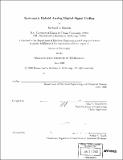| dc.contributor.advisor | Alan V. Oppenheim. | en_US |
| dc.contributor.author | Barron, Richard J. (Richard John) | en_US |
| dc.contributor.other | Massachusetts Institute of Technology. Dept. of Electrical Engineering and Computer Science. | en_US |
| dc.date.accessioned | 2009-06-30T18:46:03Z | |
| dc.date.available | 2009-06-30T18:46:03Z | |
| dc.date.copyright | 2000 | en_US |
| dc.date.issued | 2000 | en_US |
| dc.identifier.uri | http://hdl.handle.net/1721.1/46273 | |
| dc.description | Thesis (Ph.D.)--Massachusetts Institute of Technology, Dept. of Electrical Engineering and Computer Science, 2000. | en_US |
| dc.description | Includes bibliographical references (p. 201-206). | en_US |
| dc.description.abstract | This thesis develops low-latency, low-complexity signal processing solutions for systematic source coding, or source coding with side information at the decoder. We consider an analog source signal transmitted through a hybrid channel that is the composition of two channels: a noisy analog channel through which the source is sent unprocessed and a secondary rate-constrained digital channel; the source is processed prior to transmission through the digital channel. The challenge is to design a digital encoder and decoder that provide a minimum-distortion reconstruction of the source at the decoder, which has observations of analog and digital channel outputs. The methods described in this thesis have importance to a wide array of applications. For example, in the case of in-band on-channel (IBOC) digital audio broadcast (DAB), an existing noisy analog communications infrastructure may be augmented by a low-bandwidth digital side channel for improved fidelity, while compatibility with existing analog receivers is preserved. Another application is a source coding scheme which devotes a fraction of available bandwidth to the analog source and the rest of the bandwidth to a digital representation. This scheme is applicable in a wireless communications environment (or any environment with unknown SNR), where analog transmission has the advantage of a gentle roll-off of fidelity with SNR. A very general paradigm for low-latency, low-complexity source coding is composed of three basic cascaded elements: 1) a space rotation, or transformation, 2) quantization, and 3) lossless bitstream coding. The paradigm has been applied with great success to conventional source coding, and it applies equally well to systematic source coding. Focusing on the case involving a Gaussian source, Gaussian channel and mean-squared distortion, we determine optimal or near-optimal components for each of the three elements, each of which has analogous components in conventional source coding. The space rotation can take many forms such as linear block transforms, lapped transforms, or subband decomposition, all for which we derive conditions of optimality. For a very general case we develop algorithms for the design of locally optimal quantizers. For the Gaussian case, we describe a low-complexity scalar quantizer, the nested lattice scalar quantizer, that has performance very near that of the optimal systematic scalar quantizer. Analogous to entropy coding for conventional source coding, Slepian-Wolf coding is shown to be an effective lossless bitstream coding stage for systematic source coding. | en_US |
| dc.description.statementofresponsibility | by Richard J. Barron. | en_US |
| dc.format.extent | 206 p. | en_US |
| dc.language.iso | eng | en_US |
| dc.publisher | Massachusetts Institute of Technology | en_US |
| dc.rights | M.I.T. theses are protected by
copyright. They may be viewed from this source for any purpose, but
reproduction or distribution in any format is prohibited without written
permission. See provided URL for inquiries about permission. | en_US |
| dc.rights.uri | http://dspace.mit.edu/handle/1721.1/7582 | en_US |
| dc.subject | Electrical Engineering and Computer Science. | en_US |
| dc.title | Systematic hybrid analog/digital signal coding | en_US |
| dc.type | Thesis | en_US |
| dc.description.degree | Ph.D. | en_US |
| dc.contributor.department | Massachusetts Institute of Technology. Department of Electrical Engineering and Computer Science | |
| dc.identifier.oclc | 45993919 | en_US |
